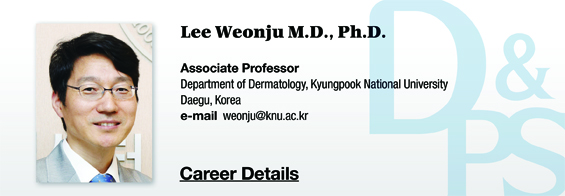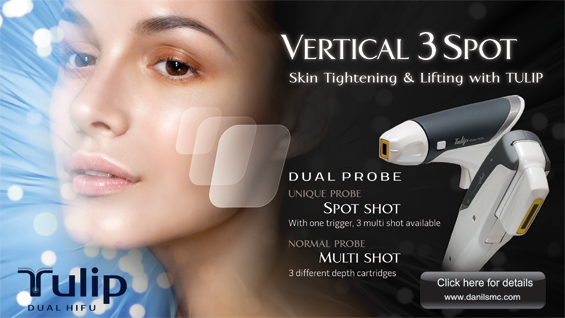▶ Previous Artlcle : #2-2. Effect and types of whitening agents
Acne is an inflammatory cutaneous disorder occurring during puberty. Acne may not be taken seriously as it is often believed to spontaneously disappear over time. However, severe acne manifesting in protruding and painful abscess and cysts is enough to cause distress in patients’ lives. Moreover, acne is often followed by dyspigmented and indented or protruding scars that cause a lot of psychological stress in adolescents or young adults who are often insecure about their appearance.
[Advertisement] Tulip(Skin Tightening & Lifting) – Manufacturer: DANIL SMC(www.danilsmc.com)
Acne is caused by various factors. Major causes include increased sebum secretion, abnormal hyperkeratinization of follicular infundibulum, bacteria such as Propionibacterium(P.) acnes and inflammatory response, etc. Excessive sebum secretion causes changes in skin barrier function which makes the skin more susceptible to inflammation. Hyperkeratinization of the follicular infundibulum leads to sebum retention which in turn triggers proliferation of P. acnes resulting in break-outs known as acne. Not only by P. acnes but various cells such as keratinocytes, sebocytes, and neutrophils as well are involved in the inflammatory response. Medical treatments of acne or cosmetic products for acne have been developed to remove these etiological factors. Many studies have focused on retinoid in the efforts to find a way to prevent excessive sebum secretion. Recently, a number of studies have examined peroxisome proliferator-activated receptor (PPAR). Studies on P. acnes investigated the role of biofilms. A biofilm has been reported to act as a bioadhesive and promote formation of comedone in some reports whereas in others it has been suggested to cause bacterial resistance as it blocks absorption of antibiotics. Studies on androgen or dietary factors are examining the role of insulin-like growth factor-1.
Types of acne treatments
Treatments of acne vary widely and include topical ointments, oral medication, skin care and cosmetic products, as well as laser procedures. The choice of acne treatment depends on the type and severity of acne lesions. Numerous modalities are being developed, however, an optimal acne treatment has not been established. Therefore, continuous efforts are needed to develop novel and more effective treatments in the future. Meanwhile, dermatologists should keep abreast of the latest developments in the field of acne treatments.
The key components of topical acne ointments are antibiotics, benzoyl peroxide, and retinoid, etc. The latest trend is to combine these components to maximize the effect and prevent bacterial resistance. Benzoyl peroxide is available in combinations with clindamycin or adapalene (a type of retinoid) and is commonly used in Korea.
Benzoyl peroxide is also used in combination with nadifloxacin or salicylic acid. Combinations with tretinoin (a type of retinoid) are also available. A study reported that a clindamycin and benzoyl peroxide combination showed effect more quickly and reduced occurrence of the resistant strain of P .acnes more effectively than the combination of clindamycin and tretinoin.
Among topical ointments, the combination of benzoyl peroxide and adapalene most effectively prevents occurrence of a resistant bacterial strain. This agent reduces key causes of acne such as hyperkeratinization of follicular infundibulum, P. acnes proliferation, and inflammatory response. Another benefit is that retinoid enhances skin permeation of benzoyl peroxide. However, it causes skin irritation in the early phase of treatment. 5% azelaic acid can be used with 2% clindamycin or erythromycin. 5% dapsone was developed and is often used with 0.1% adapalene or 4% benzoyl peroxide. Treatment with 5% dapsone alone is beneficial in mild or moderate acne that does not respond to previous topical treatments.
Latest advances in acne ointments involve development of a new formula containing commonly used ingredients. New formulas have enhanced efficacy as it increases skin permeability of the therapeutic ingredients. They are available in the forms of microsphere, liposome, nanoemulsion, and aerosol.
Microsphere formulation of tretinoin or benzoyl peroxide has been reported to improve drug delivery and reduce skin irritation. Moreover, it has the additional effect of increasing the photostability of tretinoin. Retinoic acid nanoparticles or micronized 5.3% benzoyl peroxide are also new formulas of acne treatment. The latest product is a 5.3% emollient foam of benzoyl peroxide.
Recently, a new ointment containing retinol, hexamidine diisothionate with antibiotic action and rose extracts with anti-inflammatory effect has been developed and used in mild to moderate acne. Resveratrol is another novel ointment that is known to be effective against P. acnes biofilm. The newly released taumarine bromamine is also known to have antibiotic and antiinflammatory action against P. acnes. Vitamin C ointments containing sodium L-ascorbyl-2-phosphate with antibiotic and antioxidative action is also effective in acne.
Chlorhexidine gluconate ointment and 20% sodium sulfacetamide have been introduced as new acne treatments. Many symptomatic treatments are being used in acne, however, most are ineffective with the exception of 5% tea tree oil.
-To be continued-
▶ Next Artlcle : #3-2. Cosmetic Products for Acne





















